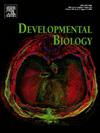Divergent Hox cluster collinearity in horned beetles reveals adult head patterning function of labial
IF 2.1
3区 生物学
Q2 DEVELOPMENTAL BIOLOGY
引用次数: 0
Abstract
Hox genes play critical roles in specifying the regionalization of the body axis across metazoa, with the exception of the anterior dorsal head of bilaterian animals, which instead is instructed by a deeply conserved set of non-Hox regulators. The anterior dorsal head is also a hot spot of evolutionary diversification, raising the question as to the developmental-genetic underpinnings of such innovation. Onthophagine dung beetles develop evolutionarily novel and highly diversified horns on the dorsal head used as weapons during intrasexual conflicts. Preliminary RNAseq data unexpectedly documented Hox gene expression in the dorsal head of premetamorphic onthophagine larvae. Motivated by this observation, we aimed to (i) investigate the genomic content and arrangement of the Hox cluster across three onthophagine species, and (ii) assess expression patterns and (iii) potential functions of the anterior Hox genes labial, proboscipedia, and Deformed in patterning the adult beetle head and cephalic horns. We document an unexpected derived Hox cluster configuration in the Onthophagus sagittarius genome, a species with apomorphic cephalic horn morphology. Yet despite this genomic rearrangement, embryonic expression patterns of labial and proboscipedia as well as the adult segment patterning functions of proboscipedia and Deformed were found to be conserved. In contrast, labial RNAi revealed an adult head patterning function outside horn-forming regions previously undescribed for any insect. Lastly, we show that electrosurgical ablation of the presumptive larval labial-expressing head region phenocopies this conspicuous adult labial RNAi defect. We discuss the implications of these data for current models of insect head development and diversification.

角甲虫的发散性Hox簇共线性揭示了成年头的唇形功能。
Hox基因在指定横跨后生动物的身体轴区域划分中起着关键作用,但两侧动物的前背头部除外,后者由一组深度保守的非Hox调节因子指导。前背头也是进化多样化的热点,提出了关于这种创新的发育-遗传基础的问题。自食屎壳郎在头部背侧进化出新颖且高度多样化的角,用作雌雄间冲突的武器。初步的RNAseq数据意外地记录了Hox基因在预变质onthophagine幼虫的背头部的表达。基于这一观察结果,我们的目标是(i)研究三种昆虫Hox基因簇的基因组内容和排列,以及(ii)评估前Hox基因的表达模式和(iii)在成年甲虫头部和头角的表达模式中的潜在功能。我们在Onthophagus sagittarius基因组中记录了一个意想不到的衍生Hox集群配置,这是一个具有非对称头角形态的物种。然而,尽管这种基因组重排,胚胎的唇和喙的表达模式以及喙和畸形的成体片段的模式功能被发现是保守的。相比之下,唇部RNAi揭示了在任何昆虫的角形成区域之外的成虫头部模式功能。最后,我们表明,电外科消融推定的幼虫唇表达头部区域表型显示了这种明显的成人唇RNAi缺陷。我们讨论了这些数据对当前昆虫头部发育和多样化模型的意义。
本文章由计算机程序翻译,如有差异,请以英文原文为准。
求助全文
约1分钟内获得全文
求助全文
来源期刊

Developmental biology
生物-发育生物学
CiteScore
5.30
自引率
3.70%
发文量
182
审稿时长
1.5 months
期刊介绍:
Developmental Biology (DB) publishes original research on mechanisms of development, differentiation, and growth in animals and plants at the molecular, cellular, genetic and evolutionary levels. Areas of particular emphasis include transcriptional control mechanisms, embryonic patterning, cell-cell interactions, growth factors and signal transduction, and regulatory hierarchies in developing plants and animals.
 求助内容:
求助内容: 应助结果提醒方式:
应助结果提醒方式:


